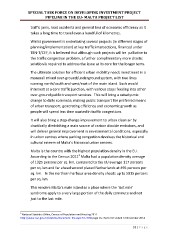Page 693 - ePaper
P. 693
SPECIAL TASK FORCE ON DEVELOPING INVESTMENT PROJECT
PIPELINE IN THE EU- MALTA PROJECT LIST
traffic jams, road accidents and general loss of economic efficiency as it
takes a long time to travel even a handful of kilometres.
Whilst government is undertaking several projects (in different stages of
planning/implementation) at key traffic intersections, financed under
TEN-T/CEF, it is believed that although such projects will be palliative to
the traffic congestion problem, a further complimentary more drastic
solution is required to address the issue at its core for the longer term.
The ultimate solution for efficient urban mobility needs investment in a
monorail mixed over-ground/underground system, with two lines
running north/south and west/east of the main island. Such would
intersect at a core traffic junction, with various stops feeding into other
over-ground public transport services. This will bring a cataclysmic
change to daily commute, making public transport the preferred means
of urban transport, generating efficiency and economic growth as
people will spend less time wasted in traffic congestions.
It will also bring a step-change improvement to urban clean air by
drastically diminishing a main source of carbon dioxide emissions, and
will deliver general improvement in environmental conditions, especially
in urban centres where parking congestion devalues the historical and
cultural esteem of Malta’s historical urban centres.
Malta is the country with the highest population density in the EU.
3
According to the Census 2011 Malta had a population density average
of 1325 persons per sq. km. compared to the EU average 117 persons
per sq. km and far ahead second placed Netherlands at 495 persons per
sq. km. In the northern harbour area density shoots up to 5015 persons
per sq. km.
This renders Malta’s main island as a place where the ‘last mile’
syndrome apply to a very large portion of the daily commute and not
just to the last mile.
3
National Statistics Office, Census of Population and Housing 2011
http://www.nso.gov.mt/statdoc/document_file.aspx?id=3998 page xiv chart 2 lst visited 12 November 2014
18 | P a g e
PIPELINE IN THE EU- MALTA PROJECT LIST
traffic jams, road accidents and general loss of economic efficiency as it
takes a long time to travel even a handful of kilometres.
Whilst government is undertaking several projects (in different stages of
planning/implementation) at key traffic intersections, financed under
TEN-T/CEF, it is believed that although such projects will be palliative to
the traffic congestion problem, a further complimentary more drastic
solution is required to address the issue at its core for the longer term.
The ultimate solution for efficient urban mobility needs investment in a
monorail mixed over-ground/underground system, with two lines
running north/south and west/east of the main island. Such would
intersect at a core traffic junction, with various stops feeding into other
over-ground public transport services. This will bring a cataclysmic
change to daily commute, making public transport the preferred means
of urban transport, generating efficiency and economic growth as
people will spend less time wasted in traffic congestions.
It will also bring a step-change improvement to urban clean air by
drastically diminishing a main source of carbon dioxide emissions, and
will deliver general improvement in environmental conditions, especially
in urban centres where parking congestion devalues the historical and
cultural esteem of Malta’s historical urban centres.
Malta is the country with the highest population density in the EU.
3
According to the Census 2011 Malta had a population density average
of 1325 persons per sq. km. compared to the EU average 117 persons
per sq. km and far ahead second placed Netherlands at 495 persons per
sq. km. In the northern harbour area density shoots up to 5015 persons
per sq. km.
This renders Malta’s main island as a place where the ‘last mile’
syndrome apply to a very large portion of the daily commute and not
just to the last mile.
3
National Statistics Office, Census of Population and Housing 2011
http://www.nso.gov.mt/statdoc/document_file.aspx?id=3998 page xiv chart 2 lst visited 12 November 2014
18 | P a g e


